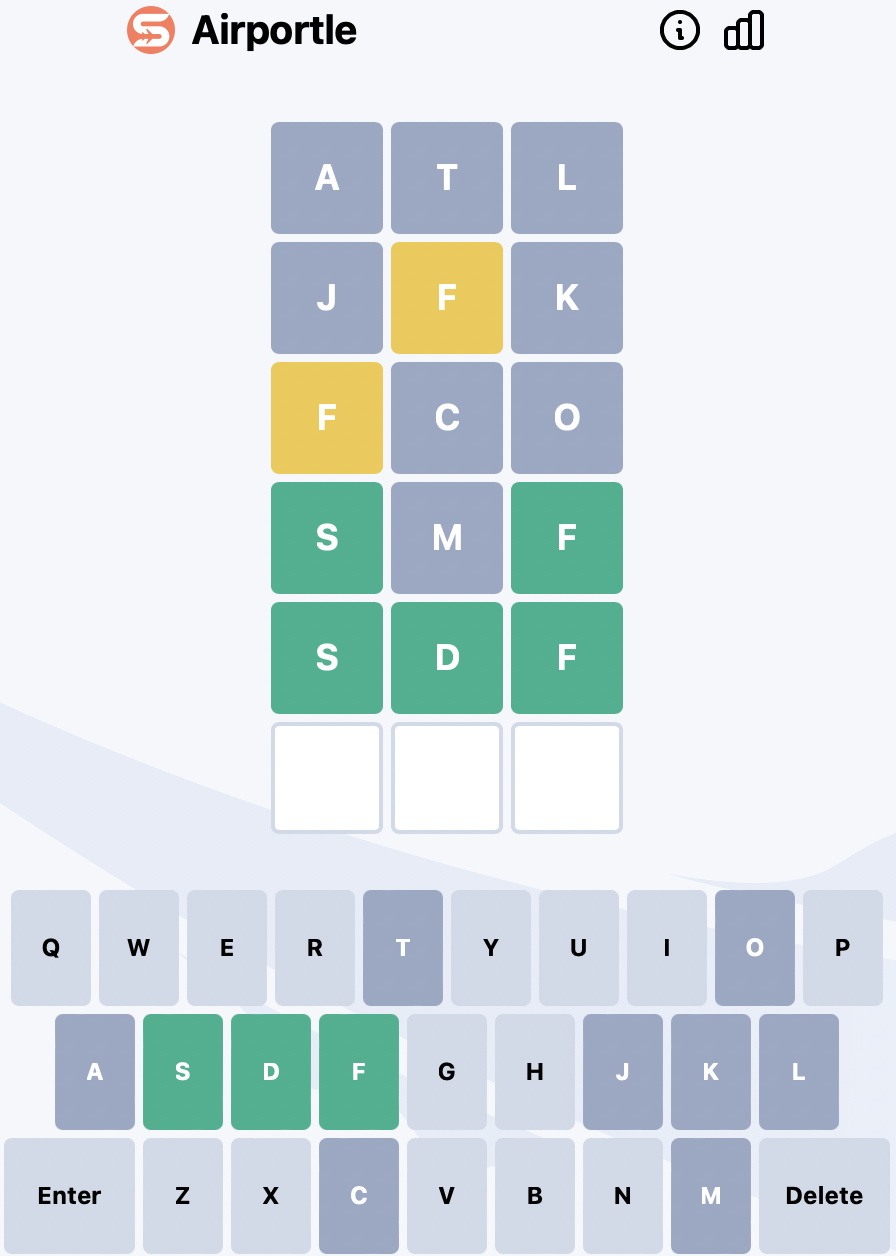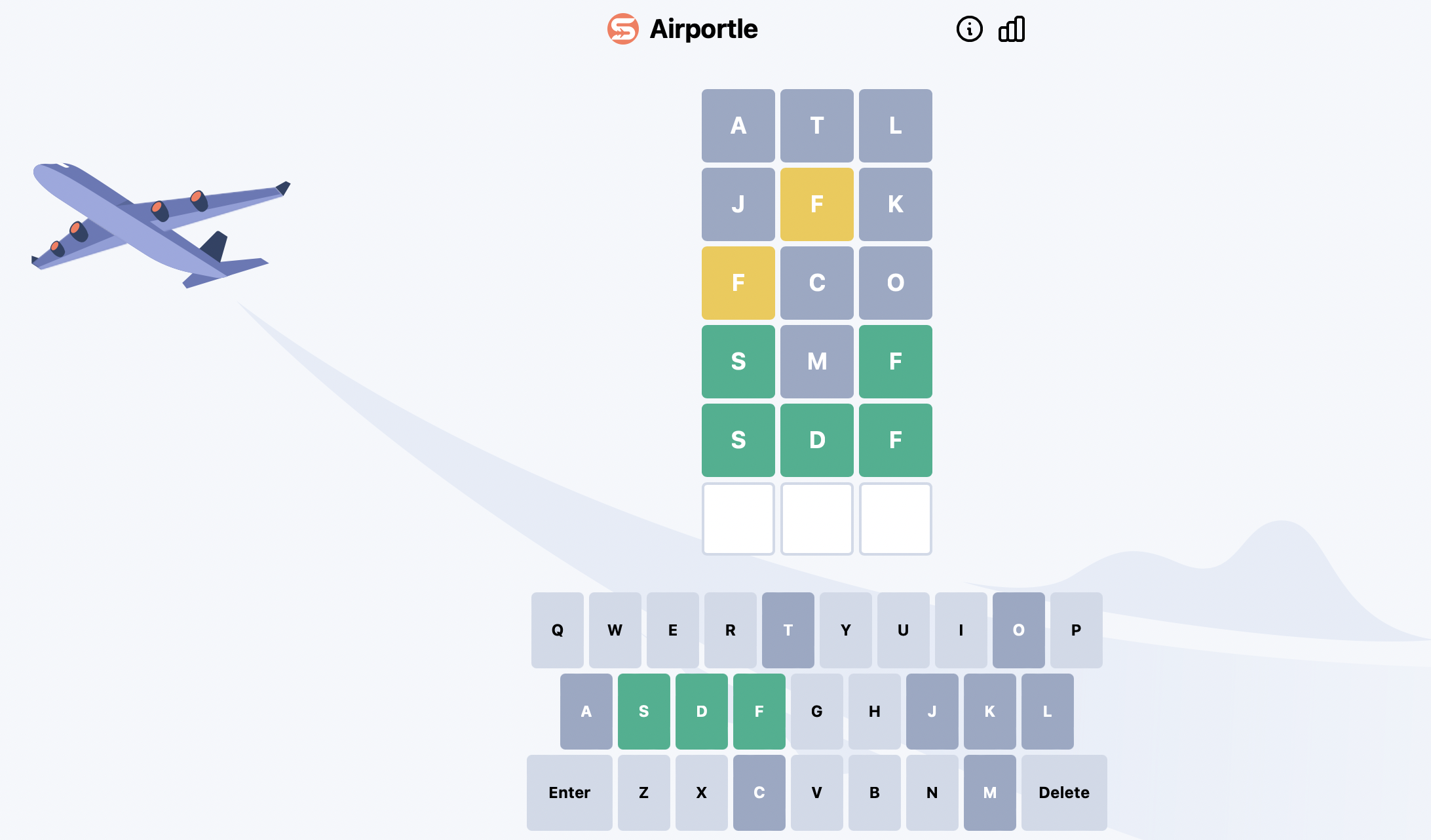So you think you know airport codes? Well, you are about to find out.
This is the ninth of a series of articles here at The Gate with which you could have some fun at testing your knowledge pertaining to airport codes — and although the first eight articles had been increasing in difficulty, subsequent articles will continue to do so as they delve into airports which are smaller and lesser known…
Airportle: So You Think You Know Airport Codes? Test Your Knowledge With This Game. Part Nine.
…but instead of the list of 50 different airport codes which are in each past article, this article is different: a game called Airportle has been released by Scott’s Cheap Flights, at which you can supposedly save up to 90 percent on the purchase of tickets for flights.

The way Airportle is played is somewhat similar to that of the popular word game Wordle and a similar game based on geography called Worldle: instead of a word, you must guess a valid official airport code of which you have six chances to guess correctly — and unlike Wordle, letters such as J, X, Q, and Z are not so obscure.
For example, the Airportle solution which is shown in the screen shot above is that of SDF, which is the official airport code of Louisville International Airport.

A Brief History Pertaining to Airport Codes
Here is a little history about airport codes…
The International Civil Aviation Organization is a specialized agency of the United Nations, established by States in 1944 to manage the administration and governance of the Convention on International Civil Aviation, which is also known as the Chicago Convention.
Airport codes designated by the International Civil Aviation Organization are comprised of four letters. The first letter generally designates a specific region; while the second letter may designate a more finite region in many areas.
For example, K is used for the continental United States — such as KATL for Atlanta and KLAS for Las Vegas — but P is used for Alaska, Hawaii, and other territories of the United States in the northern Pacific Ocean. Examples include PANC for Anchorage, PHNL for Honolulu, and PGUM for Guam.
S represents all of South America — for example, SAEZ is Buenos Aires. Y represents all of Australia — for example, YSSY for Sydney.
International Air Transport Association

The International Air Transport Association represents, leads, and serves the airline industry to improve understanding of the air transport industry among decision makers and increase awareness of the benefits that aviation brings to national and global economies. Advocating for the interests of airlines across the globe, we challenge unreasonable rules and charges, hold regulators and governments to account, and strive for sensible regulation.
Codes for airports and railway stations are comprised of three letters as designated by the International Air Transport Association. The three letters can simply represent the geographic location of the airport or railway station — or they could be based on the history or founding of the airport or railway station.
In the United States and Canada, International Air Transport Association codes are typically based on International Civil Aviation Organization codes. In the United States, the only difference between the codes is the addition of the letter K — for example as mentioned before, ATL for Atlanta is KATL and LAS for Las Vegas is KLAS. In Canada, the only difference between the codes is the addition of the letter C — for example, YYZ for Toronto is CYYZ and YVR for Vancouver is CYVR.
For most other airports around the world, International Civil Aviation Organization codes and International Air Transport Association do not resemble each other — for example:
- JNB for Johannesburg is FAJS
- FCO for Rome is LIRF
- NRT for Tokyo is RJAA
- EZE for Buenos Aires is SAEZ
- AKL for Auckland is NZAA
Final Boarding Call

I figured that if you are one of those people who wants to briefly escape the woes of the world — such as the current 2019 Novel Coronavirus pandemic or the latest winter weather or the invasion of Ukraine by armed military forces from Russia — perhaps you could use some levity for the moment.
Unlike Geoguessr — which you could play unlimited times per day at one time but was reduced to a simpler version unless you paid for the professional version — Airportle is limited to being played only once per day.
The articles are not meant to be an exhaustive list of airport codes — especially this article, which is about a specific game — but they will highlight at least 600 of them, including:
- So You Think You Know Airport Codes? Test Your Knowledge. Part One.
- So You Think You Know Airport Codes? Test Your Knowledge. Part Two.
- So You Think You Know Airport Codes? Test Your Knowledge. Part Three.
- So You Think You Know Airport Codes? Test Your Knowledge. Part Four.
- So You Think You Know Airport Codes? Test Your Knowledge. Part Five.
- So You Think You Know Airport Codes? Test Your Knowledge. Part Six.
- So You Think You Know Airport Codes? Test Your Knowledge. Part Seven.
- So You Think You Know Airport Codes? Test Your Knowledge. Part Eight.
You could test your knowledge of airport codes off the top of your head…
…or you could simply refer to this article which was posted here at The Gate back on Saturday, June 6, 2020 and find the answers using the tools which are highlighted there — but really: what is the fun in that?
How well do you know official airport codes around the world? Please feel free to share your experiences in the Comments section below.
No — no need to thank me. You are welcome. Now let’s see you be able to break away from this game after you started playing it — even if you can only play it once per day…
Unless otherwise indicated, all photographs ©2008, ©2011, and ©2017 by Brian Cohen.

